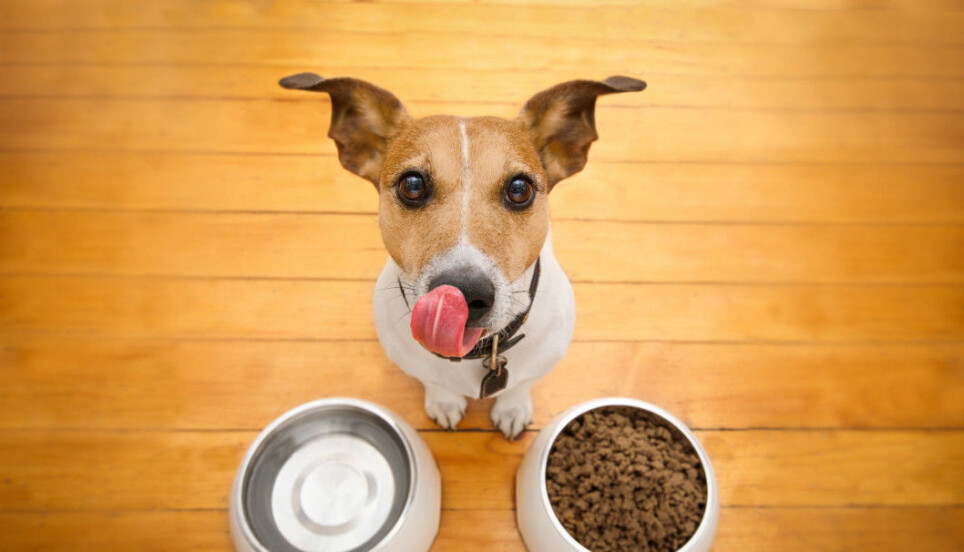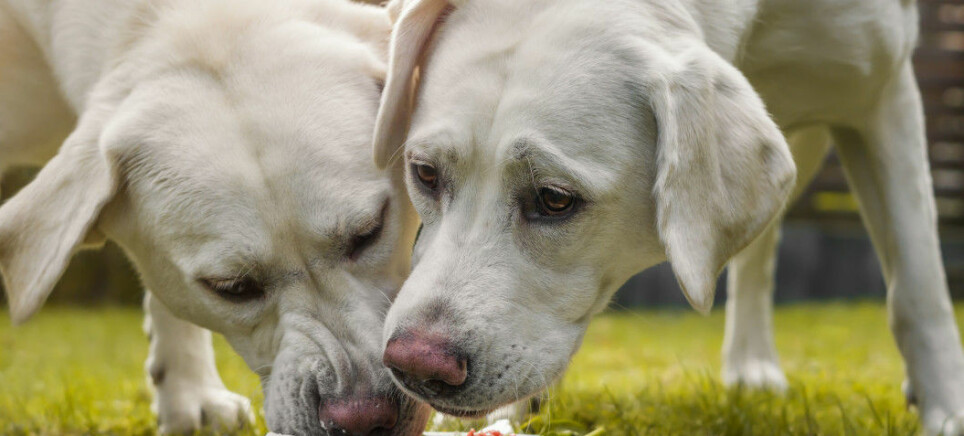
Production of pet food for cats and dogs leaves a considerable carbon paw print
Producing dry kibble for our pets requires lots of farmland — equivalent to roughly twice the area of the United Kingdom. Replace animal remains used in the feed with insects, suggests one Norwegian researcher.
More and more people are getting pets. The coronavirus is one reason, as people working in home offices acquire a dog or cat for company.
And these critters need food, which means the demand for pet food is on the rise.
As a consequence, pet food production is a growing industry.
Not great for the climate
Pet food production has a negative effect on the climate and reduces biodiversity, researchers at Edinburgh University in Scotland say.
They argue that pet food production should also be included in calculations used to make global food production more sustainable.
The researchers have now calculated our pets’ "paw" print on the environment.
Half are food plants
Dog and cat food makes up 95 per cent of the specially made food we buy for our pets. The research group first analysed the main ingredients in 280 dry food products for dogs and cats that are available in the USA and Europe.
These two regions account for two-thirds of the sale of pet food worldwide.
Half of dry feed is made from crop plants such as corn, rice or wheat. The rest consists of various animal or fish products.
Twice the area of the UK
The researchers then combined information on the volume of pet food sold with data on the environmental impact of producing the ingredients.
Approximately 49 million hectares of agricultural land are used to make dry food for our cats and dogs every year.
That’s about twice the area of the United Kingdom.
The consumption of fresh water for production is between 5 and 11 cubic kilometres. This is roughly 0.2 to 0.4 per cent of what is used for worldwide agriculture overall.
At least 50,000 tonnes of pet food purchased annually
Øystein Ahlstrøm, a professor in the Department of Animal and Aquaculture Sciences at the Norwegian University of Life Sciences (NMBU), is familiar with similar studies from the USA.
Americans alone have 163 million dogs and cats.
“It’s increasingly popular to calculate CO2 emissions and climate footprints from new industries and human activity,” he said to sciencenorway.no.
This is especially true for agriculture and food production, which account for a significant share. Dog and cat food production requires large amounts of agricultural land because there are lots of dogs and cats in the world.
There are about 900 million dogs in the world, of which 200 million have an owner. The number of cats is estimated at between 200 and 600 million.
Ahlstrøm has a dog himself, but nevertheless agrees that all the food our pets consume is worrying from a global perspective.
Equivalent to the caloric intake of 180,000 people
In Norway alone, between 50,000 and 60,000 tonnes of cat and dog food are sold annually, according to Ahlstrøm. This corresponds to the approximate energy intake of 180,000 people.
He estimates that dogs account for at least two thirds of this animal feed.

The Scottish and German researchers have also calculated the climate impact in the form of carbon footprints. The production of ingredients for pet food corresponds to emissions of 106 million tonnes of carbon dioxide, CO2.
This is more than the annual greenhouse gas emissions for countries such as Mozambique and the Philippines, the researchers say.
If one country alone had produced all this feed, it would have been in 60th overall on the top hundred list of greenhouse gas emissions sources.
This is true even though the researchers only looked at the production of dry pet food and didn’t include the production of wet food.
Prosperity makes for more pet owners
Owning a dog or cat is a Western phenomenon, Ahlstrøm says. There are about 200 million dogs in the world that have owners, and these pets have to be fed.
“This is how we humans behave. We get interested in things, but don’t think about the environmental impact,” he said.
And now this interest is spreading to other parts of the world.
“More and more people in South America, Eastern Europe and China also want to own their own dog or cat. They have become more prosperous and can afford it,” he says.
There are a total of 900 million dogs in the world, but on most other continents the dogs are wild and have to find their own food.
A lot is waste that would have been thrown away
Dog and cat food is mostly grain-based.
“These ingredients could instead be consumed by people, especially in parts of the world where there is famine,” Ahlstrøm said.
The rest of the ingredients come from animals, such as cuts from slaughterhouses, especially chicken production.
“This includes heads, feet, intestines and feathers that are treated before they are ground up. Most of these ingredients probably aren’t suitable for human consumption,” he said.
However, while people in the Western world are not used to consuming these animal parts, people in other parts of the world are better at using the whole animal.
Manufactured food ensures mix of nutrients
Ahlstrøm says that animals bring a lot of joy to the people who own them, which is why people get a dog or cat in the first place.
For modern, busy people who can afford it, it’s easy to buy prepared food for man’s best friend with the essential nutrients. Manufacturers ensure that pets get the right mix of nutrients they need in each meal.
In this sense, the animal food industry does us a great service, Ahlstrøm says.
“It feels safer for us to buy prepared food so we don’t have to think about nutrition ourselves,” he said.
Use insects instead!
But Ahlstrøm thinks the industry should consider lowering the unnecessarily high protein content in animal food by using more plant-based ingredients, as well as alternative ingredients, such as insects.
“This would result in a smaller climate footprint than using animal remains, which need to be fed first to grow,” he points out.
It’s hard to imagine not using meat and fish by-products as is done today, when there’s an ample supply and the products have no other use.
“But it seems a bit unfair to blame dogs and cats for the fact that people prefer to eat a lot of meat in the form of muscle and don’t have use for the rest of the animal, as is the case in Western countries,” says Ahlstrøm.
Smaller dogs and more leftover food
Ahlstrøm has two challenges for people who now feel guilty for owning a pet, or who dream of getting a dog.
“Large dogs have a bigger climate footprint. Smaller dogs need less food, so there’s a smaller footprint from a small dog,” he says.
Ahlstrøm himself has a Brittany, the smallest of the bird dogs.
“It is probably completely coincidental and not because of the climate, but maybe it’s enough to own just one dog,” he admits.
Four out of ten dogs are overweight
Another possibility is to add leftover food to our pet’s diet, rather than throwing it away. It’s important to provide correspondingly less kibble.
“Dogs can eat anything, such as bread, eggs, pasta, meat, fish, cooked vegetables. They may get a little upset stomach from dietary changes, and maybe the owner will need to take them out a little more often,” he said.
Cats are more dependent on eating pure protein.
“Cat owners can give more meat and fish leftovers to their cats, rather than throwing it away,” he says.
Climate footprint on packaging
He reminds people that young animals have to have food that meets their nutritional needs.
“This is especially important for young animals, such as kittens and puppies. They need a lot of calcium to build a healthy skeleton. Food producers generally put a lot of ground bone and limestone in this feed,” he said.
Norwegians use four times more resources than they need to if they were to live sustainably.
“That's why it matters what we do. Animal food producers should put the climate footprint of their product on their packaging, so people can choose food that has the smallest footprint,” Ahlstrøm said.
The analysis was performed by Peter Alexander at the School of Geosciences and the Global Academy of Agriculture and Food Security at the University of Edinburgh in collaboration with the Karlsruhe Institute of Technology in Germany.
Translated by: Nancy Bazilchuk
References:
P. Alexander et al.: The global environmental paw print of pet food. Summary. Global Environmental Change, November 2020.
G. S. Okin: Environmental impacts of food consumption by dogs and cats. PLOS ONE, 2 August 2017.
———
Read the Norwegian version of this article on forskning.no
































